 Re: Interview with Eric Cheng
[Re: James Morrissey]
#35329
Re: Interview with Eric Cheng
[Re: James Morrissey]
#35329
05/30/11 11:32 PM
05/30/11 11:32 PM
|
Joined: Feb 2005
Manhattan, New York, New York
James Morrissey
 OP
OP
I
|
 OP
OP
I
Carpal Tunnel
Joined: Feb 2005
Manhattan, New York, New York
|
Part I: About Eric Cheng 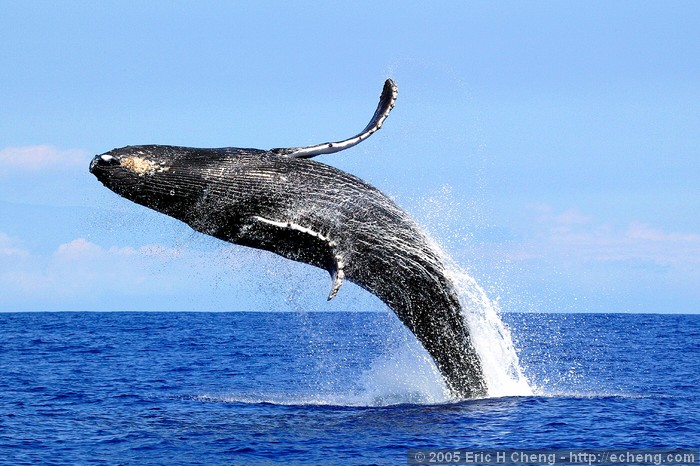 (c) Eric Cheng JM: Would you be willing to tell us a little about yourself? EC: Of course! JM: Can you tell us a little about what life was like when you were growing up? EC: I was born in 1975 in Madison, Wisconsin, to Taiwanese immigrants who came to America for graduate school. Two years later, we moved to San Diego, California, where I spent my childhood. I have one sister. I was pushed hard when I was a kid, and spent my time outside of school playing classical music, sitting in front of the computer, and lighting things on fire.I moved to the San Francisco Bay Area for college, where I pursued undergraduate and graduate degrees in computer science. During school, I spent an equal amount of time pursuing music as I did computer science. In fact, most of the time I felt more at home in the music department than I did on a computer in some dingy basement. JM: Do you have a family of your own? EC: Not at the moment. I am really close to my sister, and have some friends whom I basically consider to be my local family. At an age where most of my friends are just starting families, I'm (unfortunately) about as far away from marriage as I can imagine! JM: When and how did you first begin to photograph? EC: I remember being interested in photography during junior high and high school, but for some reason I never took it seriously.When I left home for college, I took with me my father's old 35mm Pentax SLR, which I had rescued from the depths of a storage closet. I carried it around with me obsessively and constantly took snapshots of the people around me.In 1998 (during graduate school), I borrowed a 0.5 megapixel digital camera from Stanford University. The thing used floppy disks for storage, and the images it captured were noisy and barely adequate for web use! Even so, using it changed my life. I saved up $1,000, bought my own digital camera, and continued to informally document the people and things around me. During this time, I experimented with digital infrared photography, and in general was fascinated by the things my digital camera could capture that traditional film could not.I also used to keep salt-water reef aquariums, and through them developed a love for the ocean. On a whim, I took a camera underwater during a trip to Palau in April, 2001, which put me on a path toward photography that I could not have dreamed of. JM: What is your photographic education? EC: I am 100% self-taught.I tried to get into photography courses during college, but the classes were so over-subscribed that students outside of the art department were only admitted via a lottery system (I lost).I've always had a knack for figuring out how things work, so the technical aspects of photography have never been a problem. I knew my film cameras very well, and given my background, the migration of photography to digital only made things easier.The less tangible, subjective aspects of photography -- composition, lighting, mood, etc. -- are harder things for me to talk about. I am very much an intuitive shooter and tend not to think very much when I shoot. I only know that a frame is pleasing -- or not -- and while the reasons can usually be accounted for by well-known photographic principles, it is rarely the case with me that I am driven by the principles themselves.Equally important to being educated in photographic technique and philosophy is being educated about the subjects that one shoots. Most of my subjects these days are wild marine animals, and most of the work in getting photos of such animals involves figuring out how to get close to them. 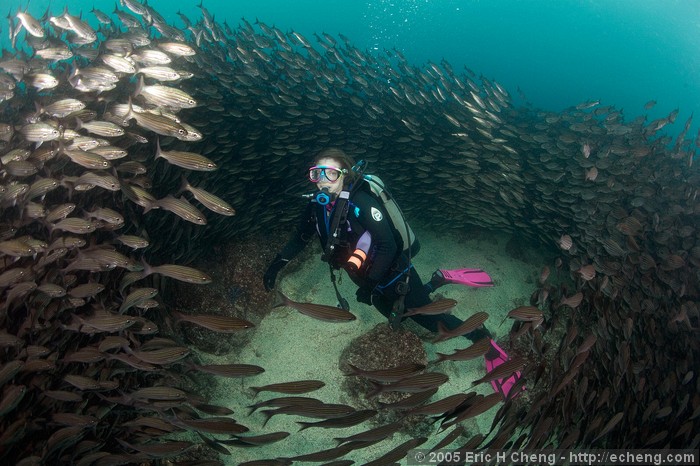 Nature, Wildlife and Pet Photography(c) Eric Cheng JM: Where does your knowledge of marine life come from? EC: About the time I started scuba diving, I started maintaining a reef aquarium. Part of keeping marine animals involves learning about their behavior -- and, how to keep them alive. But the vast majority of my knowledge of marine life comes from experience in the water. Nature photography goes hand-in-hand with behavioral biology, and it's hard to do one without studying the other. I also learn a lot from talking with friends in the industry and from the associated follow-up work that happens when figuring out what you have just photographed. I spend a lot of time with my nose buried in critter ID and behavior books. JM: How long have you been in business? EC: I've been shooting professionally as an underwater photographer for somewhere between two and three years, although I started to be published seven years ago for work with digital infrared photography. JM: What made you feel that you could take this professionally? EC: I'm not sure, actually. So far, the transition into professional photography has been one full of decisions, and I still feel like I'm trying to answer this question for myself. JM: Is Photography a first profession for you, or have you done other things as well? EC: My first profession was in the software industry. I got out of graduate school during the middle of the technology boom, and immediately went to work for a small startup company in Silicon Valley, which was really exciting. Unfortunately, it was all-consuming and a bit too narrow of a life for me, so I resigned in 2001 with no idea where I would go next.I still occasionally take short contracting jobs to keep my software skills sharp, but I'm also noticing that photography is in the progress of a complete transition to digital technology. Because of this, I find that I often end up being as much of a technology guy as I am a photographer.I also dabble as a classical cellist, which still battles with photography as my primary passion. It's not easy to practice the cello when you're gone half the year. JM: If photography is not a 'first' profession, how did you decide to enter the door and become a professional photographer? EC: I sometimes tell people that photography chose me, instead of the other way around.When I left my job, I had plans to take a break and travel the world for a bit before figuring out what to do next, so I bought an underwater housing and strobe for my little digital camera and went scuba diving in Palau. When I returned home, I uploaded all of the photos onto my website in the form of a travel journal, and went about my normal life.But during the trip, I met the owner of a dive resort in Bora Bora, who later invited me to create a website for his resort. Along with a designer friend of mine, we were responsible for all of the photography, design, and implementation of the site -- all on location. Naturally, I put some of these images online, as well.It just so happened that people were really starting to reply on internet search engines at that time. A little site called Wetpixel (which at that time was single-page news service for underwater digital photography) needed someone to provide daily web coverage via satellite of a digital photography expedition to Kona. David Breitigam, the owner at that time, found me on the web and invited me along to cover the trip.For various reasons, I took over Wetpixel shortly after, re-launching it as a community site and online magazine of sorts, focused on digital underwater photography.During the Kona trip, I met and befriended photographer Jim Watt, who eventually introduced me to the greater underwater photographic community. I started doing a lot of underwater photography, using the web as a medium for the publication of stories and images.Everything I was doing at the time was geared toward the enablement of additional travel -- without breaking the bank. To do this, I entered and won photo competitions (which often give out trips as prizes) and traveled extensively with working pros. In addition to burgeoning friendships, we each had something the other wanted: I had expertise in digital imaging, and they had decades of experience in the water. Things change quickly. In 2001, if you had asked me what my plans were for the next four years, I would never have guessed that I'd be an underwater photographer. 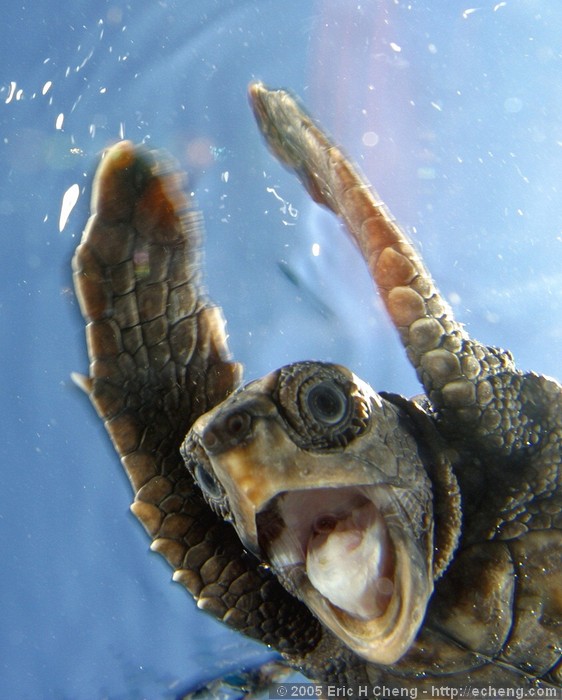 Nature, Wildlife and Pet Photography(c) Eric Cheng JM: Do you recommend any resources for underwater photography? EC: WETPIXEL.COM, of course!  It's a fantastic, online community for underwater photographers.Aspiring photographers should also pick up books by their favorite published underwater photographers. Critter-ID books are also a good resource. JM: You mentioned your trip to Palau and how it changed you in a way you could never have dreamed of. Photographically, what is driving you to succeed? What is it that you feel calls you to this specific milieu? EC: I just love that so much of the ocean is still a mystery to us; we're really only beginning to explore its depths. There's some irony in the fact that it's been lapping at our cities since the Very Beginning, yet we only choose to turn our attention to it after we had destroyed so much of its inhabitants.If you would like to see more of Eric's work, please feel free to check out his websites at: http://www.wetpixel.com/http://www.echeng.com.Just a friendly reminder that this article is Copyright 2005, James Morrissey, and may not, in part or in whole, be reproduced in any electronic or printed medium without prior permission from the author. The images in this article are the property of Eric Cheng and have been licensed to James Morrissey and the NWP Photo Forum for the purpose of this interview.
|
|
|
 Interview with Eric Cheng - Part II
[Re: James Morrissey]
#35330
Interview with Eric Cheng - Part II
[Re: James Morrissey]
#35330
05/30/11 11:42 PM
05/30/11 11:42 PM
|
Joined: Feb 2005
Manhattan, New York, New York
James Morrissey
 OP
OP
I
|
 OP
OP
I
Carpal Tunnel
Joined: Feb 2005
Manhattan, New York, New York
|
Part II: The Business Aspects of Photography with Eric Cheng 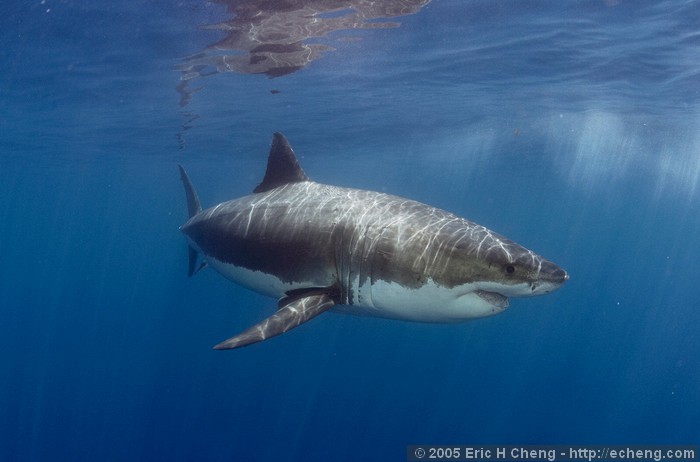 Nature, Wildlife and Pet Photography (c) Eric Cheng JM: Can you describe what your business looks like? EC: My business is actually a combination of many things. I sell stock images, write articles for magazines, lead trips, teach workshops, run an online web community, do a bit of software consulting, and very occasionally, play gigs as a cellist. JM: How does Wet Pixel fit into your business plan? EC: Wetpixel started as a labor of love. I never imagined that it would eventually be such an important part of my identity. Wetpixel is now a fantastic international community and is a large part of my business plan. I've found that one of the biggest challenges to getting started as an underwater photographer is financing the necessary trips into the field. Because Wetpixel's audience is larger than some dive magazines, my involvement gives me the credibility I need to establish contact with various organizations that would otherwise be difficult to break into. Wetpixel's audience is excited about learning and travel, and the workshops and trips I've run are almost exclusively populated with our members. The community is also a tremendous source of information. JM: Besides the photographs that you have sold to various magazines, what other types of commercial photography are you doing? EC: I'm just now starting to do assignment work for dive magazines. Outside of sales to magazine and books, I've also done some portrait work - mostly for friends. I also plan to sell prints online and I am working on the infrastracture necessary to get everything online in the right way. JM: How are you getting exposure - both the website AND your photographic materials? EC: My exposure has been through two main channels: the web, and word of mouth. In addition to Wetpixel, I have been running a personal website since the mid-90s. It has become a huge repository of information that I've tried to organize as best as I can. Somehow, during the course of the past eight years, my personal website has ended up linked from quite a few magazines and newspapers -- and from hundreds of blogs and other miscellaneous sites. Needless to say, it has a high Google ranking. And because everyone uses Google for pretty much everything now, people tend to find me in the strangest of ways. As for worth of mouth exposure, the underwater photographic community is very small. Having Wetpixel certainly helps me to get exposure, but I'm also always sharing information and images with pretty much everyone I meet (who shows an interest, I mean) when I'm on the road. JM: It has been said many times that the biggest part of running a business is not actually doing your trade, but knowing how to RUN a business. How have you educated yourself in running a successful business? EC: Good question! I struggle daily with the fact that my business is currently run in an informal manner. But mostly, it is because I want to keep my career path on my own terms. I don't want to formalize things so much that I will no longer be able to move quickly when something new presents itself. 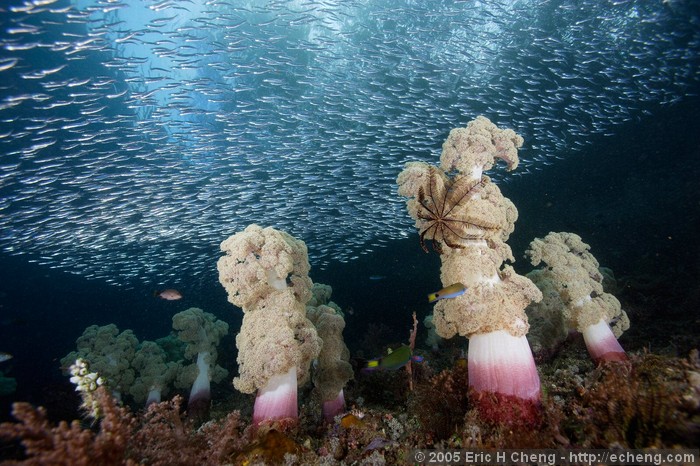 Nature, Wildlife and Pet Photography (c) Eric Cheng JM: What have been the big pieces of 'getting seen' in the photographic community? How is it that you have been able to thrive so quickly? EC: I was very fortunate because I had the right skill-set at the right time. I also became friends with professionals in the industry who wanted to leverage those skills (in addition to burgeoning friendship, I mean). I would say that the biggest piece for me was my predisposition for sharing information on the web. I tend to share information freely and publicly, which is great for building up a community like Wetpixel -- and, for meeting people. I probably met a majority of the underwater photographers in the United States within two years of taking a camera underwater. Incidentally, nearly all of them tell me that it's an industry that isn't worth getting into.  Also important was that I had some money saved up from a prior job, which allowed me to travel for a couple of years to establish credibility through a small portfolio of good work. Otherwise, it might have taken me a decade or more. The importance of this cannot be understated. Keep your day job! JM: What skill sets do you think are important for underwater photography? How are they different from other forms of nature photography (besides the obvious need for a wetsuit  )? EC: Underwater photography is very challenging, and you should be a strong scuba diver before attempting to take a camera underwater. I see many people with cameras smashing into everything in their path, and it's unfortuate to the animals they are damaging. Also, you can put yourself and everyone with you at risk if you aren't prepared for what the ocean might throw at you. Aside from the whole water thing, it's just like being on land. Understanding the animals you are photographing is very, very important. Once you know where to find something, the rest is up to persistence, patience, execution, and luck! JM: When was the first time you were published? EC: My first published image was a picture of the sign of a seedy club in Seattle. The sign read, "Come see OUR Windows 95!," and PC Magazine picked it up as a joke image. My second publication streak came as a result of experimentation in digital infrared photography, when digital cameras first hit the market (more at http://www.echeng.com/photo/infraredwww.echeng.com/photo/infrared. 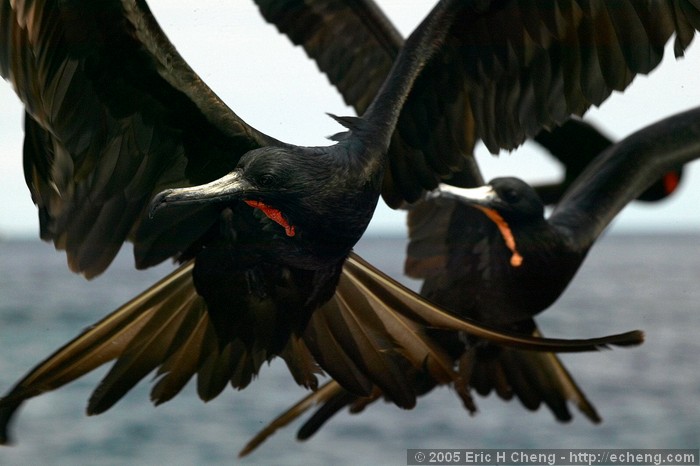 Nature, Wildlife and Pet Photography (c) Eric Cheng JM: Is your photographic business what you had planned it on being when you had started? EC: I didn't have any plans when I started, so all of this is new to me. I feel like I'm paving the path ahead of me as I'm walking on it. JM: What plans do you make for your business over the next year? How do you see yourself expanding your business (both artistically and financially)? EC: Personally, I'd like to shift more towards assignment work related to exploration, research, or conservation, as opposed to tourism or the pursuit of stock images, neither of which I am particularly interested in. Having said that, I plan to formalize a stock library of images while not actually actively trying to fill its gaps. I've said this before, but I'm careful with the decisions I make because I want to keep photography on my own terms. If I find myself doing things related to photography just to make money, I might simply decide to return to my old industry, which pays enough to allow a passionate pursuit of photography as a serious hobby. It's better to retain passion than to allow it to twist into obligation. Regarding Wetpixel, I plan to expand into the photography expedition business (we already have three trips planned for next year), and to try to provide a way to leverage the amazing images our members are sharing with the community. JM: Do you want to talk a bit about your workshops and business trips? EC: Sure! For the past couple of years, I've been giving workshops and seminars at various dive and underwater photography expos and festivals (DEMA, Seaspace, and Boston Sea Rovers). I've also started staffing on-site workshops, and leading my own expeditions. Next week, I'll be teaching at the Digital Shootout 2005, which will be held in Bonaire this year. We'll have about 40 participants, with a staff of 4 pros. So far in 2006, I'm leading trips to Guadalupe http://wetpixel.com/guadalupe Great White Sharks (with Norbert Wu), the Bahamas http://www.wetpixel.com/i.php/full/wetpixel-shark-expedition-march-2006 tiger and great hammerhead sharks , and to South Africa http://wetpixel.com/i.php/full/wetpixel-sardine-run-expedition-2006the sardine run. If you would like to see more of Eric's work, please feel free to check out his websites at: http://www.wetpixel.com and http://www.echeng.com.
|
|
|
 Interview with Eric Cheng - Part III
[Re: James Morrissey]
#35331
Interview with Eric Cheng - Part III
[Re: James Morrissey]
#35331
05/30/11 11:46 PM
05/30/11 11:46 PM
|
Joined: Feb 2005
Manhattan, New York, New York
James Morrissey
 OP
OP
I
|
 OP
OP
I
Carpal Tunnel
Joined: Feb 2005
Manhattan, New York, New York
|
Part III: Under Water Photography Basics with Eric Cheng 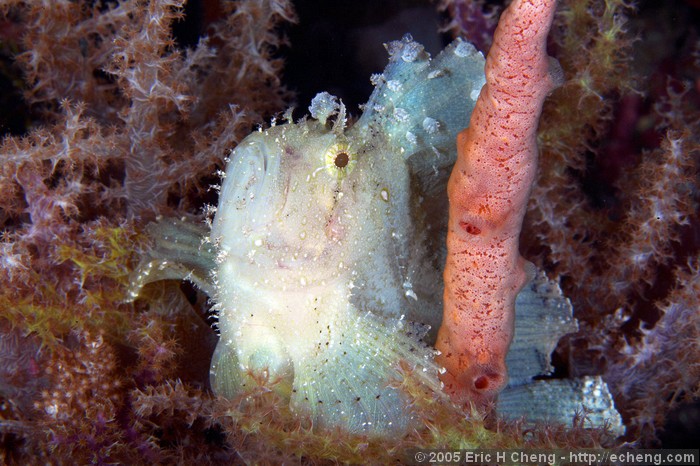 Nature, Wildlife and Pet Photography (c) Eric Cheng JM: What certifications do you need to go underwater to begin with? EC: At many resorts around the world, just about anyone can go underwater in what is commonly referred to as a "discovery dive," which is a one-time dive that consists of an instructor strapping a lot of weight on someone and throwing her into the ocean. But if one wants to get underwater regularly, there are quite a few acronymed organizations that offer classes for "proper" SCUBA certification. Typically, classes include instruction on the basics of dive-related equipment, physics, and safety, and take anywhere from a few days to several weeks to complete. Getting certified as a diver prepares you to SCUBA dive safely and legally. JM: What equipment do you need? EC: At the minimum, one needs a well-fitting mask, snorkel, and fins. In cold-water locations, most dive shops also require personal neoprene gloves and booties. The rest -- wetsuit/drysuit, buoyancy compensating device (BCD), regulator, dive computer, tank, and weights -- can be rented. However, all serious divers dive with their own equipment (everything but tank and weights); my gear is what keeps me alive and maneuverable underwater, and being familiar with it is very important. JM: How much money do you think it takes to START to do this? EC: Basic SCUBA certification costs anywhere from US $200-300, plus "personal" gear (mask, snorkel, fins, booties, and gloves), which will set you back at least $200. If you only own personal gear, you'll have to rent equipment each time you dive, which can get expensive if you do a lot of diving. JM: What photographic gear are you using? What lenses and other gear do you prefer to use? EC: I use a Canon 1Ds Mk II in a Seacam housing, with Ikelite DS-125 and INON Z-220 strobes. The lenses that I favor underwater are the Canon 15mm/2.8 full-frame fisheye, Tokina 17mm, Sigma 20mm/1.8, Canon 24mm/1.4L, Canon 35mm/1.4L, Sigma 50mm macro, Canon 100mm USM macro, and Canon 180mm USM macro. I use a Canon 1D Mk II as a backup, or as a topside camera when the other one is in the housing. I picked the Seacam housing because it is the highest-quality housing on the market. At the time, it was also the *only* housing for the 1D series camera.  I like to use equipment that just works. I don't need to admire the gear, nor stroke it because it is so beautiful. I'd rather have gear that I don't need to think about -- gear that just works. 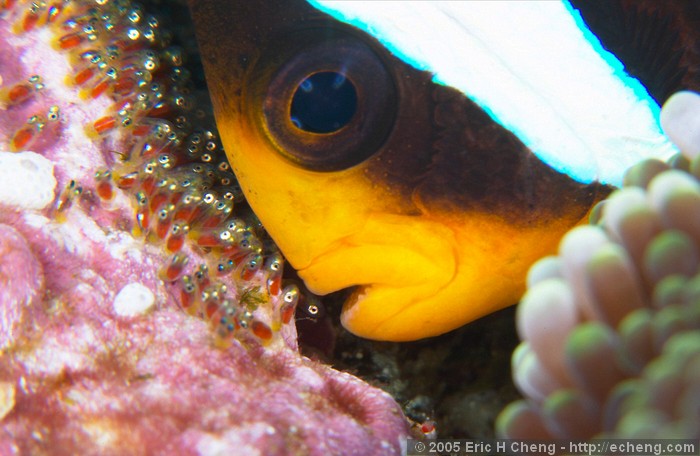 Nature, Wildlife and Pet Photography (c) Eric Cheng JM: Why did you pick the light system you did? EC: I use Ikelite DS-125 strobes and INON Z-220 strobes. The Ikelites produce a very pleasing image and have a nice, circular beam. The INONs are smaller, and built like small, uh... plastic tanks.  I use Fisheye modeling lights at night. JM: What is it like going underwater with your camera system and housing? EC: Underwater, my housed camera and lighting system is like a part of me; I have probably only spent one or two of the last several hundred dives without my camera. Actually, I can't remember the last time I dove without it! Maneuvering underwater with a large camera can be very difficult in extreme current. Anyone who has tried to drag a large object through the water knows that it takes a considerable amount of effort to do so. I use a lot more air when I have my camera with me, and it took me some time before I became relaxed enough to breathe normally. Sometimes, having a large camera underwater is comforting. Specifically, I like having the large chunk of metal around when I am in the water with curious sharks.  Inexperienced divers usually find going underwater with a photography rig to be very challenging, and I often see divers with cameras trashing the reef (without noticing their actions, I mean). For the sake of the underwater environment, I recommend relative mastery of SCUBA diving skills before attempting to take a camera underwater. 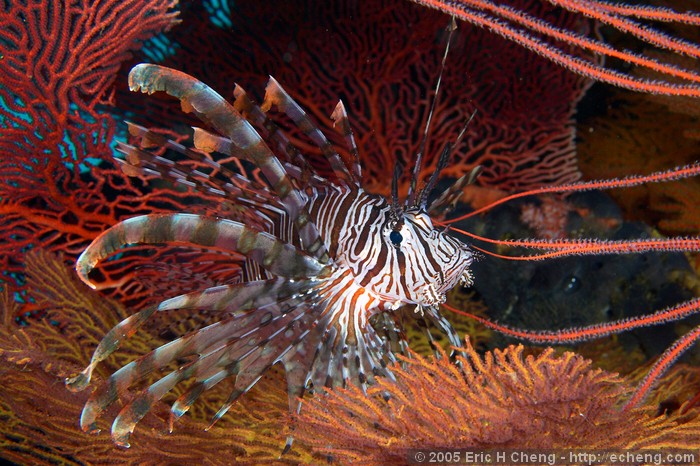 Nature, Wildlife and Pet Photography (c) Eric Cheng JM: What does this all do with your camera insurance? EC: We underwater photographers use specialized insurance for our gear, which covers theft, flood, and damage in harsh environments. Specifically, most of us use DAN's H2O Insurance ( http://www.h2oinsurance.com/) or D.E.P.P. ( http://www.equipmentprotection.com/programs/depp.html). Some people try to add riders to home-owners or renters insurance, but I've heard horror stories about being dropped from policies after making claims. Personally, I'd rather not gamble with my home-owners insurance. JM: Can you tell us more about the physical experience of going underwater? EC: A lot of my friends tell me that they're afraid to go underwater because they are claustrophobic -- which has always confused me. The experience of being underwater in clear water evokes quite the opposite of claustrophobia. Rather, it is the complete freedom of motion in three dimensions! Drifting along in strong currents is probably as close to flying as one can get, and using one's lungs to ascent and descend adds a dimension to maneuverability that I've learned to really enjoy. The real reason we all go underwater is to be exposed to the amazing wildlife. Nature goes completely crazy underwater, and animals look bizarre and are commensal in ways that we land creatures could never have imagined. JM: What marine environments do you prefer to work in? EC: Well, I prefer warm, crystal-clear water, but that isn't always available where there is interesting wildlife.  JM: Where are your favorite places to photograph? (It had better not be someplace landlocked - smile  EC: I don't really have favorite places to photograph, but I've spent a lot of time diving time in the Bahamas, Galapagos, and South Pacific -- all of which I love. I love the Bahamas for its incredible large shark action, the Galapagos for its whale sharks, hammerheads, and amazing and bizarre topside wildlife, and the South Pacific for its incredible diversity in marine life. I also really like French Polynesia for its water clarity and amazing schools of gray reef sharks. If you would like to see more of Eric's work, please feel free to check out his websites at: http://www.wetpixel.com and http://www.echeng.com.
|
|
|
 Interview with Eric Cheng - Part IV
[Re: James Morrissey]
#35332
Interview with Eric Cheng - Part IV
[Re: James Morrissey]
#35332
05/30/11 11:49 PM
05/30/11 11:49 PM
|
Joined: Feb 2005
Manhattan, New York, New York
James Morrissey
 OP
OP
I
|
 OP
OP
I
Carpal Tunnel
Joined: Feb 2005
Manhattan, New York, New York
|
Part IV: Eric Cheng on the Environment 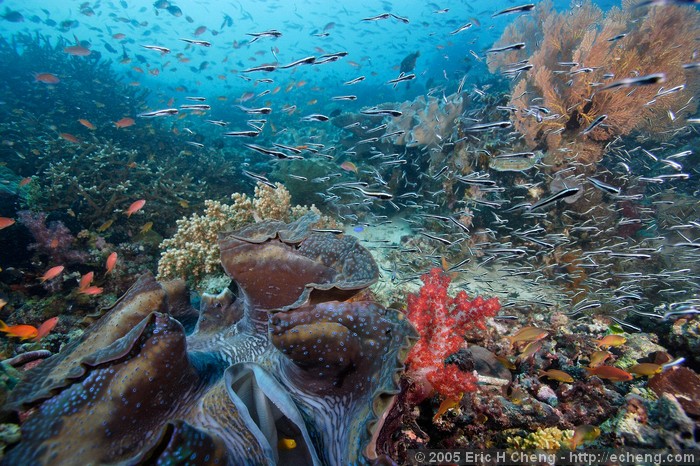 Nature, Wildlife and Pet Photography" border="1"></td></tr></table> (c) Eric Cheng JM: Do you consider yourself an environmental activist? If so, why? EC: Definitely. Anyone who is frequently on the ocean sees first-hand the devastation we, as humans, are causing out there. JM: What are the most significant environmental problems that you see coming? EC: Overfishing is a huge problem in general, but one particular flavor of overfishing that is particularly offensive to me is shark-finning. Shark-finning is not only completely unsustainable, but also extremely cruel and wasteful; sharks are finned while still alive, and then left to die in the ocean. Between 30 and 100 million sharks are killed each year for the Asian shark-fin market. It's almost enough to make me ashamed of my own heritage -- which may sound strange, but is something I've also heard other Asian underwater photographers say. JM: How have these issues impacted your photographic work? EC: Definitely. I spent all of December in Irian Jaya, which is just about as far away from everything as you can get. We dove many areas that should have had sharks all all over the place (in particular, high-current, underwater "points"), but after three weeks, we had seen only seen one or two -- really depressing. In April, I dove a pass in the Tuamotus (French Polynesia) that had been cleaned out of sharks only a few months earlier. We saw only a few sharks there (mostly juveniles), but friends who had been there even a year before reported a population of hundreds. I can't even imagine how people who have been diving for twenty or thirty years feel about the steep decline of our ocean's populations. JM: Do you feel that the issues you see in the water are similar to the environmental issues we are hearing about on land. If so, how are they similar? EC: We kill things and pollute, and people only tend to rally for animals that are cute. Although, all of the activism that forced Disney to overturn their decision to serve sharkfin soup at Disney Hong Kong was heartening. 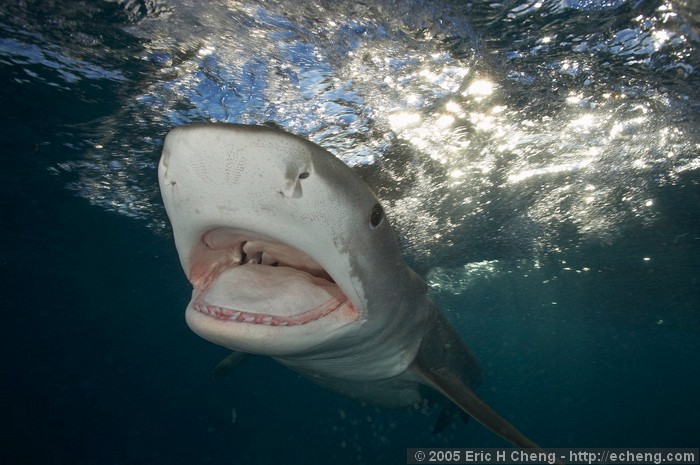 Nature, Wildlife and Pet Photography (c) Eric Cheng JM: What can we do as individuals to be helpful? EC: An easy thing individuals can do is to be responsible about eating seafood. Boycotting shark fin soup is a no-brainer, but other decisions are harder. The Seafood Watch page at http://www.montereybayaquarium.com/cr/seafoodwatch.asp the Monterey Bay Aquarium's website is a good resource for finding out how to stay healthy and responsible while eating seafood. You can even download a handy reference card to keep in your wallet. JM: What organizations, if any, do you feel are making successful in-roads on helping the environment? EC: My favorite ocean conservation organizations are Shepherd and WildAid. Sea Shepherd takes action when it comes to conservation, stationing boats for patrolling preserves, getting photographers and videographers in front of mass slaughter, and confronting whaling vessels on the open ocean. WildAid's mission is to end illegal wildlife trade, and has been effective at using the media to get news out to as many people as possible. They are also very efficient as a conservation organization, channeling 100% of donated funds directly into the field. 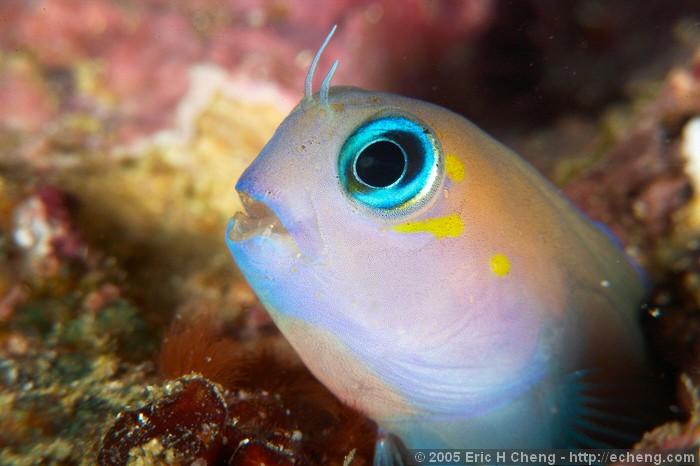 (c) Eric Cheng If you would like to see more of Eric's work, please feel free to check out his website at: http://www.wetpixel.com. As always, we encourage you to come join the community and to be participants here at http://www.nwpphotoforum.com
|
|
|
|
|
0 registered members (),
165
guests, and 4
spiders. |
|
Key:
Admin,
Global Mod,
Mod
|
|
|
Forums6
Topics628
Posts992
Members3,317
| |
Most Online876
Apr 25th, 2024
|
|
|